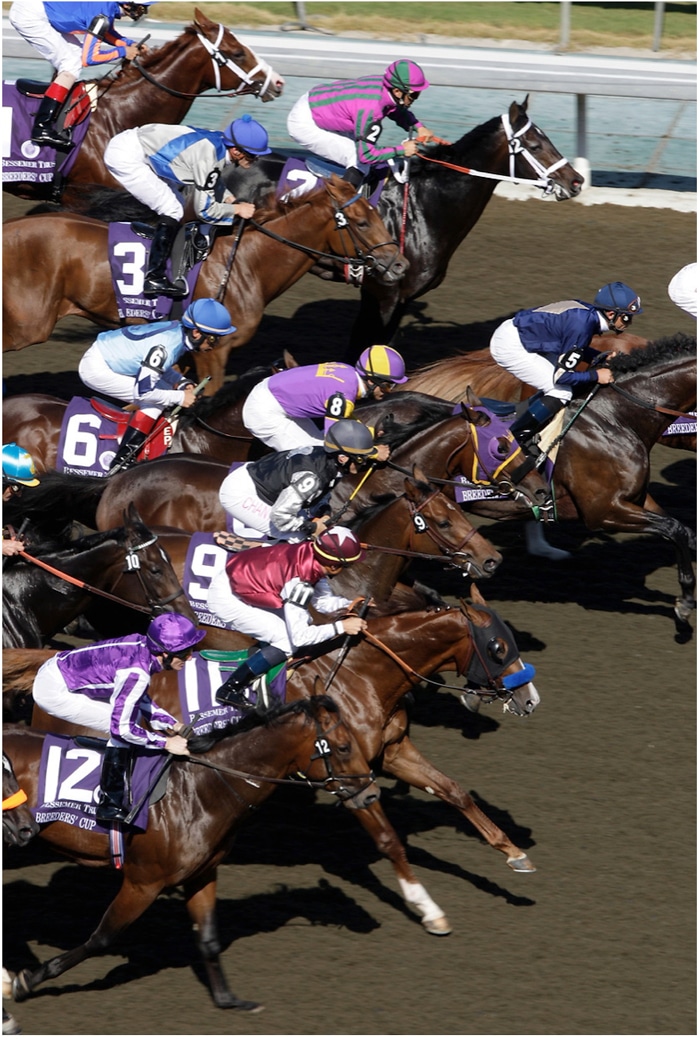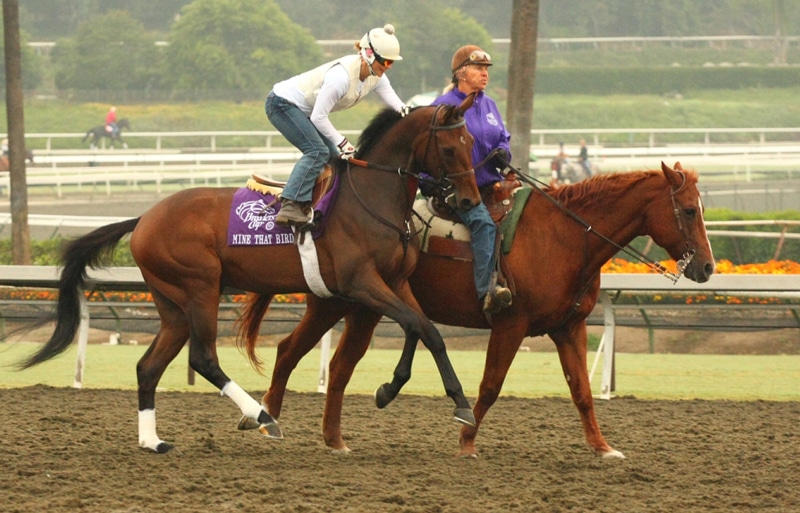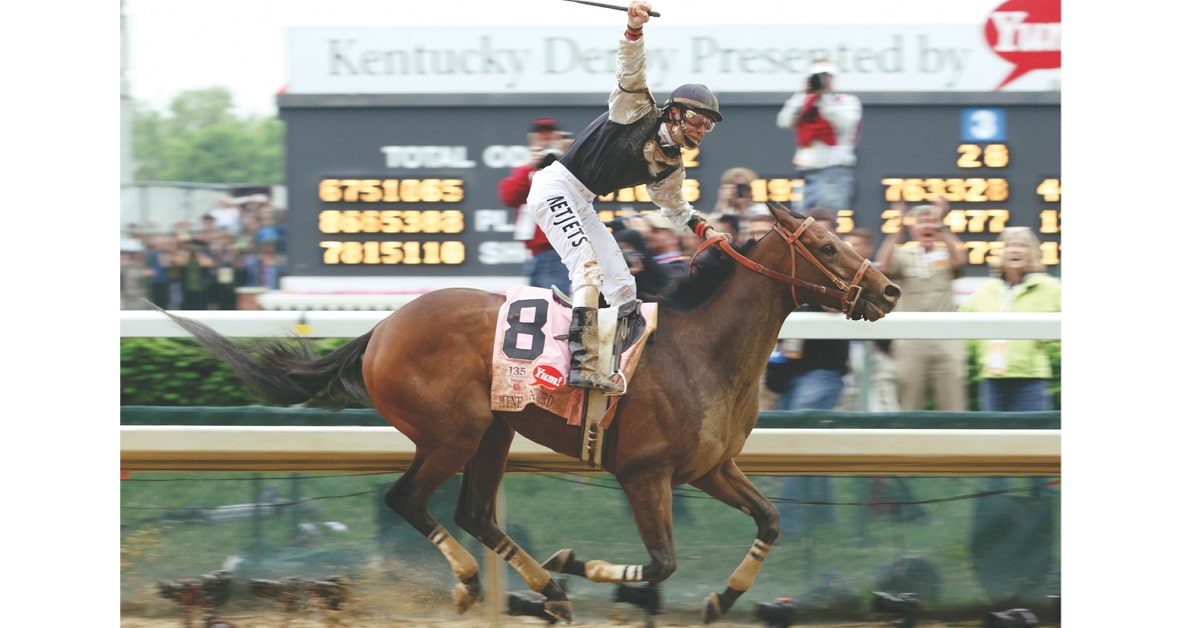Mine That Bird’s unlikely road to immortality began on May 10th, 2006, when he was born at a Kentucky farm belonging to Blackburn & Needham/Betz Thoroughbreds, with co-breeders Peter Lamantia of Toronto and partners Jim Blackburn (IL), and Phil Needham and Bill Betz (KY). His dam was the unraced Mining My Own, by Smart Strike (who also sired Curlin and Lookin at Lucky); the colt’s father, Birdstone, had won the 2004 Belmont Stakes after a stirring homestretch battle, preventing the legendary Smarty Jones from capturing the Triple Crown.
In 2007, Mine That Bird’s breeders decided to part with the colt while he was still a yearling. The little colt was consigned to the Fasig-Tipton fall yearling sale, where he was purchased for a mere $9,500 by Canadian trainer David Cotey. At the auction – where many of the yearlings were overwhelmed by the rush of noise and attention – the trainer had been struck by how relaxed Mine That Bird seemed. Cotey also remembers that “he had a beautiful, beautiful walk to him.”
Immediately after the sale, the trainer sent Mine That Bird to Ontario’s Pine Valley Training Centre to begin his education.
As soon as Mine That Bird arrived in Canada, Pine Valley co-owner Gemini Caine was convinced that a brilliant future awaited him. “He really stood out to me,” she recalls. “There are some horses when you just know they’re on the shed… they kind of draw that attention to them. And although he [Mine That Bird] was small and plain, he was that horse.”
She added, “We might have two hundred horses go through our property every year, and then there’s only a handful that you really remember… but he was one that I loved.”

Mine That Bird (#9 with Chantel Sutherland up) chases a swift pace in the Breeders’ Cup Juvenile. (Breeders’ Cup photo)
The newly-gelded Mine That Bird possessed a massive personality. “I gave him a soccer ball in his stall,” Caine remembers, “and he would throw it out of the stall at you when you walked by. One morning I went into his stall and he had peeled every section individually off and put them in his feed tub. He was a weird little dude!”
As the public would later discover, the gelding also had a penchant for peppermints – and, according to one witness, nibbled at people when they were slow to present the treats. “He was very good, very smart, and happy to train,” Caine said. “I loved him. I told Dave right away that this would be his best horse.”
When Mine That Bird was sent back to Cotey to prepare for the races, the trainer adamantly agreed. “He was just a gentleman to be around and to train,” he recalls. “In his races, he would relax and be wherever you wanted him … he had the desire to win.”
On July 20th, 2008, Mine That Bird made his first start at Woodbine Racetrack. After lagging in ninth place for much of the race, he launched a respectable rally to finish fifth. Two weeks later, Cotey entered the gelding into a claiming race, where bettors promptly made him the second-longest shot in the six-horse field.
Mine That Bird quickly proved them wrong. After chasing the pace from the middle of the pack, he charged into first and won by 1 3/4 lengths. Afterwards, Cotey boldly nominated his horse for Woodbine’s $100,000 Silver Deputy Stakes. “He ran such a nice race the first time, the way he relaxed, and I thought that was a place we should go with him,” the trainer remembers. “And it was going further, which I knew would help him.”
For the two-year-old’s upcoming race, Cotey hired Chantel Sutherland – a champion jockey who, after playing field hockey for Canada’s Junior World Cup team, decided to pursue a lucrative career in thoroughbred racing – to ride Mine That Bird.
Despite being pushed wide near the final turn, Mine That Bird romped past his opponents to win by two lengths. With Sutherland riding him, the gelding quickly earned two more victories – including one in the Grade 3 Grey Stakes.
Mine That Bird’s latest victory caused a trainer called Bennie “Chip” Woolley to take note. Along with one of his clients, Mark Allen, Woolley travelled from New Mexico to examine the gelding.
The two horsemen were an unlikely team. Twenty-five years ago, they had first met at New Mexico’s LaMesa Park. “We didn’t like each other at first,” Allen admitted. “We were fixin’ to probably lock horns.” One night, however, Allen angered several people in a local bar and got caught up in a ferocious fight. “Chip came in and helped me out,” Allen remembered. “There were about five of them, two of us, and we done all right. We’ve been friends ever since.”
When it came to Mine That Bird, both horsemen were convinced that he had great promise. Along with his racing partner, Leonard Blach, Mark Allen shelled out $400,000 for Mine That Bird and brought him to the United States.
At first the move didn’t appear to suit the gelding. Twenty days after the Grey Stakes, Mine That Bird paraded to the post for the $2,000,000 (USD) Breeders’ Cup Juvenile. After starting well, he was pushed wide and finished last. Despite this lackluster performance, the gelding’s earlier races in Canada earned him a Sovereign Award as the Champion Two-Year-Old Colt.
Following his loss in the Breeders’ Cup Juvenile, Mine That Bird returned to New Mexico, where he made his three-year-old debut in the Borderland Derby and finished a close second. He followed his impressive performance with a fourth-place finish in the rich Sunland Derby. While the gelding’s races hadn’t particularly helped his reputation, they had made him eligible for the Kentucky Derby.
His handlers were hesitant about the idea. “To tell you the truth,” Allen confided, “I was scared. In the Kentucky Derby, you’re running against D. Wayne Lukas and Bob Baffert.”

Mine That Bird at Santa Anita Park in 2008.
Allen and Blach decided to take the risk anyway. Once Mine That Bird had been entered into the Derby, Chip Woolley led his horse into a van, attached the trailer to his pickup truck, and drove nearly 1,500 miles to Churchill Downs.
On Derby day, Mine That Bird and his 18 opponents made their way to the starting gate. With three consecutive losses, the gelding was sent off at 50-1 odds. Mine That Bird was “squeezed” as he left the gate; soon after, he settled into last place.
Just when it looked like Mine That Bird was hopelessly beaten, his jockey, Calvin Borel, swung him to the rail and asked him the question. The result was unexpected and almost unbelievable.
Mine That Bird accelerated dramatically and took off after the leaders, swerving through the dense pack of horses with lightning speed. With just over a furlong to go, the gelding drew beside front-running Join in the Dance. His outside path blocked, Borel aimed his mount at a “tiny gap” between Join in the Dance and the infield rail. Mine That Bird burst through the hole and emerged in front, running easily. He extended his lead and crossed under the wire, 6 3/4 lengths in front.
Watching the race from Ontario, Caine and her husband, Paul, were stunned. “We screamed so loud,” she says, “that the neighbours came to check on us.”
The second-longest shot to ever win the Derby, Mine That Bird also chalked up the greatest victory margin since Assault’s 1946 win.
After his astounding performance in the Kentucky Derby, Mine That Bird ran in the Preakness Stakes, where he finished second to Rachel Alexandra, the first filly to win the race since 1924. The gelding concluded his Triple Crown campaign with a third-place finish in the Belmont Stakes.
Although Mine That Bird would never win another race after the Kentucky Derby, the memory of his unlikely victory and his sublime courage lingers to this day.
“I still don’t believe it happened,” Caine marvels. “But I love that it happened.”


